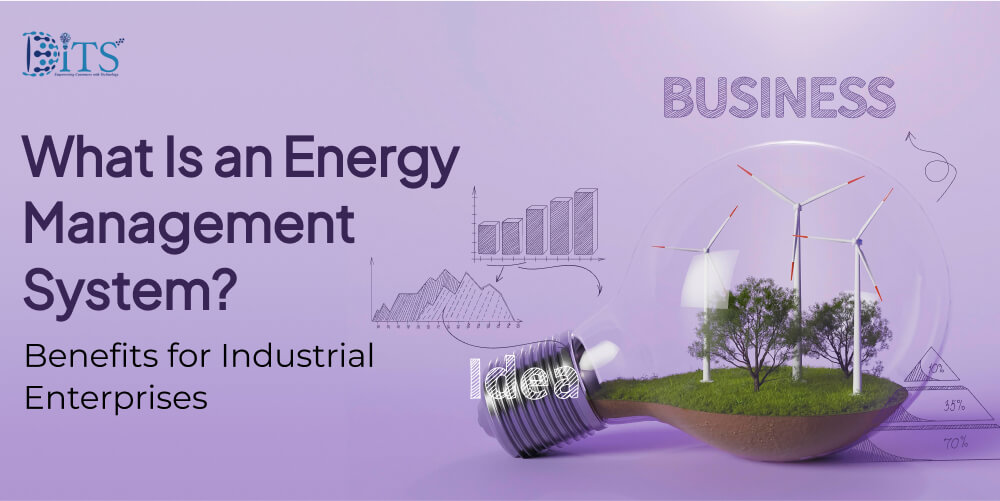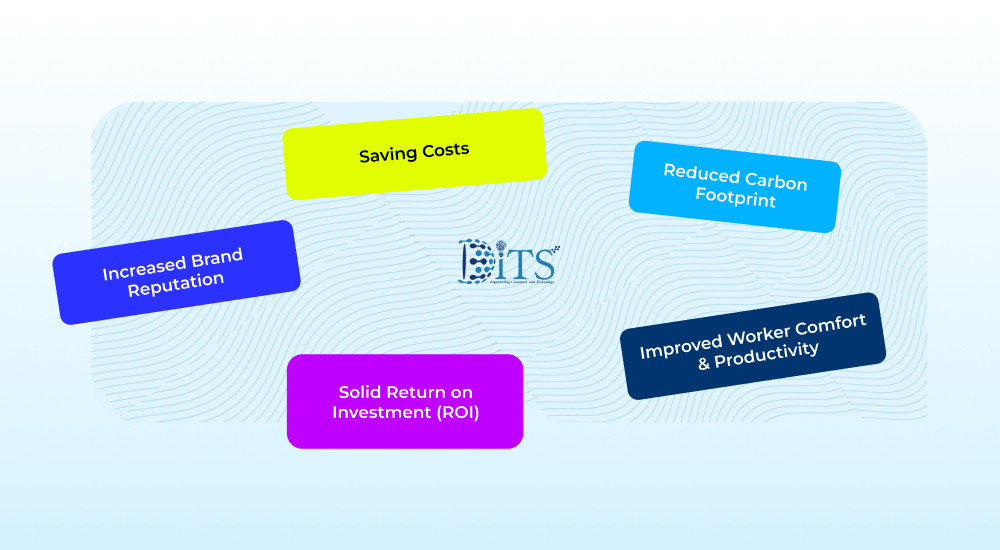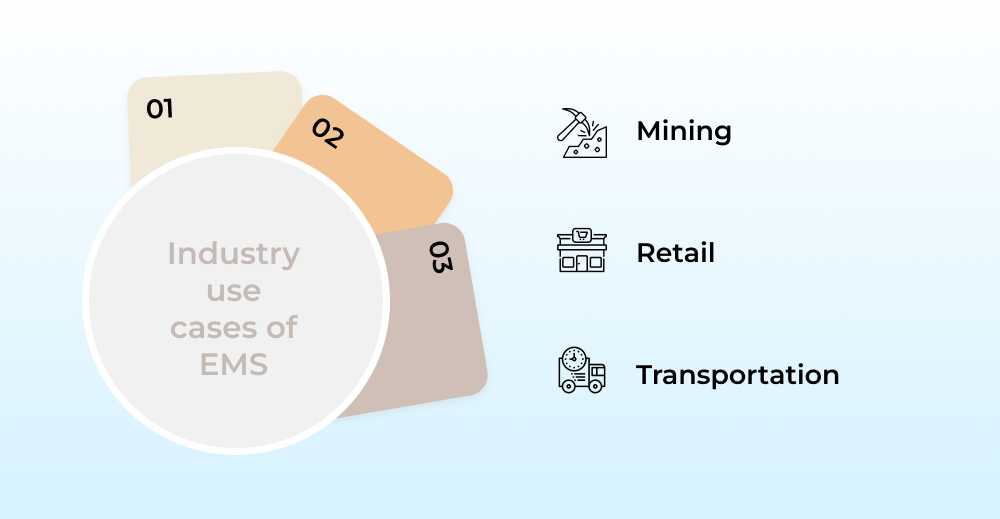What Is an Energy Management System? Benefits for Industrial Enterprises
Ditstek Blogs
The current business environment is highly competitive, and reducing overhead is crucial to survival and growth. Everyone considers utility bills as just another expense, whereas the wise ones in charge of companies view them differently. Predictive maintenance programs and energy efficiency programs offer significant value to organizations for managing operational costs.
With an energy management system (EMS), companies can monitor, analyze, and optimize energy usage. Rather than simply paying or disregarding the bill or a fraction of the utility bill, it provides them with visibility into where power is being used and how savings can be achieved. The information from these systems ultimately supports leaders in making better decisions, improving functionality, and reducing costs over time.
Core Components of EMS
An EMS is not a single tool, but a bunch of systems working together. Some are simple, such as smart meters that quietly track every kilowatt-hour of energy usage. Others are more advanced, such as dashboards that allow managers to see what's happening across the plant in real-time.
Then there are sensors; tiny, inexpensive devices attached to equipment that continuously feed data about the amount of energy each machine is consuming. Pair those with automation tools, and suddenly, lights, cooling systems, or heavy equipment can adjust on their own without waiting for a human to flip the switch.
Reporting is another piece. Instead of wading through endless spreadsheets, the software generates quick insights: charts, trends, and alerts that say, "Hey, this motor is running hotter and costing more than usual." That's the kind of detail that saves money before problems snowball.
And here's the kicker: it doesn't stop at being a standalone system. Good EMS software for enterprises integrates with existing platforms, such as production systems, ERP, and even maintenance tools, so that the data flows naturally. No double work. No silos. Just a single view of how energy drives operations.
Are You Still Guessing Your Energy Usage?
Real-time visibility transforms your energy bill into strategy. Learn how advanced EMS tools give you the control you need.
Benefits of an Energy Management System for Industrial Enterprises

Here are the benefits of Energy Management Systems for Enterprises
1. Saving Costs
One of the primary benefits of using an Energy Management System (EMS) is the reduction in everyday operational expenses, including heating, cooling, lighting, and water usage. An EMS will provide historical access to data to assess the energy usage trends over time. In this way, it is much easier to forecast energy costs and make more informed economic decisions from a financially savvy perspective.
As many businesses continue to recover financially from the pandemic's impacts, facing various challenges in the face of rising costs, determining ways to cut unnecessary costs and expenses is more crucial than ever. In fact, studies show that organizations can save as much as 40% on their energy expense in the first year of implementing the Energy Management System.
2. Reduced Carbon Footprint
The carbon footprint associated with a building is directly related to the amount of energy it consumes. An EMS will enable an organization to actively view and record energy usage, monitor consumption, and identify areas for improvement to reduce greenhouse emissions.
According to the International Energy Agency (IEA), the building and construction sector consumes nearly 30% of the total energy consumed globally and is a significant contributor to carbon emissions (a 40% contributor).
As governments worldwide begin to enforce lower emissions and take action on climate change, creating more innovative energy strategies for all buildings is essential. Research has indicated that by 2040, we could reduce global energy consumption in buildings through the EMS by as much as 10%.
3. Improved Worker Comfort & Productivity
An Energy Management System (EMS) not only conserves energy but also contributes to healthier and more comfortable work environments. You can control various systems, such as HVAC and lighting, to provide an ideal working environment for your employees.
Research shows that 60% of office workers are dissatisfied with the controls over temperature and lighting, which impact their productivity levels. Did you know that close to 90% of your employees say they had issues with temperature and/or lighting in one year? An EMS will help you eliminate this issue; with this, their workplace is much "greener" and employees' round will take place with greater participation.
4. Solid Return on Investment (ROI)
While it can be costly to install an EMS, the energy-saving features generate a quick return on investment. Whether to limit energy usage during peak hours, detect a leak, or create revenue-generating programs, EMS systems can pay for themselves faster than they were anticipated.
To maximize your ROI with an EMS, it is essential to personalize the system for the facility. For example, hospitals may require a higher level of energy usage at all times, while organizations may use more energy during peak hours during the day and much less overnight. Overall, customizing the EMS will guarantee the best operational costs and energy use in the facility.
5. Increased Brand Reputation
Ultimately, implementing an Energy Management System can improve your company's reputation. Increasingly, companies across all industries are being evaluated and incorporated into their sustainability practices. The fact that organizations are taking steps to reduce energy waste (and increase efficiency) resonates not only with environmentally conscious customers, but it also has positive consequences for their reputation with investors and stakeholders.
In short, an Energy Management System (EMS) does more than reducing costs: it may be the information your business needs to future-proof your processes, improve employee comfort (during working hours), and put your brand closer to the top of the sustainable brand ladder.
Industry use cases of EMS

Factories are usually the first to come to mind. In large manufacturing plants, energy demand shifts wildly throughout the day. An EMS tracks those spikes and helps managers balance workloads, ensuring machines don't consume more power than necessary. Some even tie production schedules to cheaper off-peak hours, a simple move that yields significant savings.
Mining
Mining is another big story. Heavy equipment, extended operating hours, and remote locations can significantly drive up costs. By implementing Energy Management in the Mining Industry, companies can reduce wasteful energy consumption from trucks, drills, and ventilation systems. For a sector where margins depend on volume and efficiency, this shift significantly helps companies cut costs and improve profits.
Retail
Retail warehouses are also catching up. Think about endless rows of lights and climate systems running day and night. An IoT-based energy monitoring system enables the dimming of lights in empty aisles or the automatic adjustment of cooling when outside temperatures change. Minor tweaks here save massive amounts across hundreds of sites.
Transportation
Transportation hubs and logistics centers are also prime candidates. Transportation and Logistics Management, combined with energy monitoring, helps operators optimize fuel and electricity usage in fleets, cold storage, and automated sorting lines. Less energy is burned, resulting in lower costs and reduced emissions, a win on both sides.
Even service-intensive industries, such as data centers or healthcare facilities, see results. For them, reliability is everything. The use of the Internet of Things in the Energy Sector ensures that power loads don't overwhelm critical systems while still trimming unnecessary usage.
Ready to Optimize Energy and Cut Overheads?
Industrial leaders use intelligent energy management systems to slash costs and boost performance — find out how yours can too.
Why Industrial Enterprises Should Invest in EMS
Energy prices are no longer steady; they rise, fall, and spike in ways that make planning nearly impossible. For industries where margins are tight, those swings can wipe out profits faster than most realize. That's why companies can't afford to treat efficiency as a side project.
An industrial energy efficiency approach gives them a competitive edge. It's not only about cutting bills, it's about staying resilient when costs fluctuate or regulations tighten. Governments worldwide are enforcing stricter carbon targets, and the businesses ahead of the curve will adapt without scrambling at the last minute.
There's also pressure from the market itself. Partners, investors, and even customers want proof that operations are responsible and sustainable. Having the systems to back up those claims doesn't just check a box, it builds credibility.
And here's the bigger picture: investing now sets the stage for growth. When energy waste is under control, budgets open up for innovation. Teams stop reacting to problems and start planning for the future with confidence.
The sooner enterprises adopt innovative practices, the sooner they will shield themselves from risks that are unlikely to slow down anytime soon.
Why Choose DITS for Energy Management Solutions
Not all enterprises need the same setup. A mining operation in remote terrain has very different requirements compared to a retail chain managing dozens of warehouses. That's why off-the-shelf tools often fall short. What makes a difference is a tailored design, software that matches the business, not the other way around.
At DITS, we've spent nearly a decade building custom platforms for industries ranging from healthcare to transportation, mining, and retail. We have a 97% client retention rate, because we focus on creating solutions that actually solve problems rather than just adding more dashboards. For companies seeking long-term sustainability, we design EMS software for enterprises that scales with growth, rather than becoming a bottleneck.
Another strength? We bring AI into the process itself, whether it's in development, testing, or code quality. That means faster delivery, more innovative customization, and fewer hiccups after launch. It's not just a promise of innovation, but a way to ensure each solution is future-ready from day one.
Is Your Facility Wasting Hidden Energy Costs?
Discover how an energy management system reveals inefficiencies and saves thousands annually. Let data drive your next big saving.
Conclusion
Energy has ceased being just another number on the bill, to the extent that it is now influencing the success or failure of industrial enterprises. An energy management system helps these enterprises achieve the clarity and control they need to avoid wasting electricity, save money, meet sustainability expectations, and stay focused on their ultimate goal.
The shift is no longer optional. Markets have become increasingly competitive, regulations have become tougher, and clients have begun to require greener operations. Businesses that act now gain more than just savings; they gain resilience and credibility that will carry them into the future.
FAQs
What is the primary role of energy management systems in industry?
The primary aim is to provide companies with control over their energy consumption across their entire physical footprint. By monitoring consumption in real-time, companies now have visibility into areas of inefficiency, which helps reduce costs and achieve sustainability goals.
How does an EMS operation reduce operational costs?
Using real-time monitoring and analysis of the data system, an EMS will find instances where assets are using more energy than necessary. Solving or fixing these "hidden" energy drains will help lower monthly charges and prolong equipment life.
Can an EMS mesh well with older equipment?
Yes, however, with older equipment, additional sensors and custom connectors are often needed. Many companies will take a phased approach to implementing an EMS, focusing on essential equipment first. As strong practices and culture evolve, the EMS implementation can expand further.
Which industries will see the biggest benefits from EMS solutions?
Manufacturing plants, mines, retail warehouses, transportation terminals, and healthcare facilities will all see considerable savings. Each industry will utilize the system's information differently; however, the same outcome of waste reduction and greater efficiencies will be accomplished.
How long will the payback take when implementing an EMS?
Most companies will begin to see measurable savings within the first year. The duration will vary based on the size of operations, energy costs, and the time it takes for crews to adopt new practices.

Dinesh Thakur
21+ years of IT software development experience in different domains like Business Automation, Healthcare, Retail, Workflow automation, Transportation and logistics, Compliance, Risk Mitigation, POS, etc. Hands-on experience in dealing with overseas clients and providing them with an apt solution to their business needs.
Recent Posts
Get in touch








.jpg)

